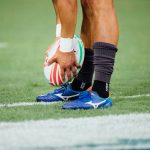
Tinea Pedis, more commonly known as Athlete’s Foot is a fungal infection which develops on the skin of your foot, usually between the toes, but can spread further. Some bad cases can also spread to the hands.
The reason it’s called Athlete’s Foot is that athletes are the most likely to be the ones suffering from it. The infection is usually contracted through cross-contamination with someone else or, from a surface that someone with it has come in to contact with it. Swimming pools are the ideal place to pick up this mild, yet annoying infection.
Why so annoying? Not only is it irritating and itchy to the skin, but it can also sometimes be difficult to treat. Because the fungus develops more in warm and moist environments – something that an athlete is constantly faced with – sometimes it can seem like it just doesn’t want to go away.
With 75% of people in Canada expected to suffer from some form of foot issue in their life (Athlete’s Foot being a common one), we wanted to help you out with our tips and tricks to try and prevent and treat it.
Prevention
There are a few ways to help prevent getting Athlete’s Foot in the first place.
Don’t walk barefoot; especially in public places
Swimming pools, gyms, and locker rooms are a breeding ground for the fungus that causes Athlete’s Foot. By simply always wearing flip flops when you go to such places, you can drastically reduce the chances of getting it.
Don’t share socks or towels
The thing about the fungus is it’s easily transferable which means you shouldn’t be sharing things that make contact with your feet with your friends. Towels and socks are the most common. In addition to this, make sure they’re washed thoroughly after each use on a warm wash to kill off any potential bacteria.
Washing and DRYING your feet correctly
It may seem simple, but effective washing of your feet, and more importantly, drying them can make a world of difference. That means really getting between your toes when you’re drying them to make sure there’s no excess moisture. Also, wearing socks made from sweat-wicking fabrics such as merino wool will help to make sure that your feet stay dry throughout the day.
Treatments
Drugs
There are several over the counter (OTC) medicines on the market that can treat the condition including miconazole (Desenex), terbinafine (Lamisil AT) and butenafine (Lotrimin Ultra). In addition to ointments, you can also look into taking an oral medication to combat the infection quicker.
Though these are effective it can still take several weeks or months to fully ward off the fungal bacteria that caused the infection in the first place. While undergoing treatment, we also recommend doing the tips we suggested above for prevention to lower the chances of spreading or reinfecting the area.
Natural Remedy – Tea Tree Oil
Over in the UK, people seek more natural methods to treat Athlete’s Foot. TheGoodEstate Expert Sophia King strongly recommends tea tree oil. Each case is of course, individual, but it has proven to have been very effective in more than 50% of cases.
This is because its ingredients have properties that kill off bacteria; hence why it’s also used a lot in the prevention and treatment of acne. It should, however, be used sparingly as it can irritate some users. We suggest applying it with a clean Q-tip.
We hope these tips will help you to treat, and ideally prevent you ever getting Athlete’s Foot in the first place; whether you’re running a marathon or just a hobbyist swimmer, these tips are sure to help anyone from at-home fitness enthusiast to professional athlete.










